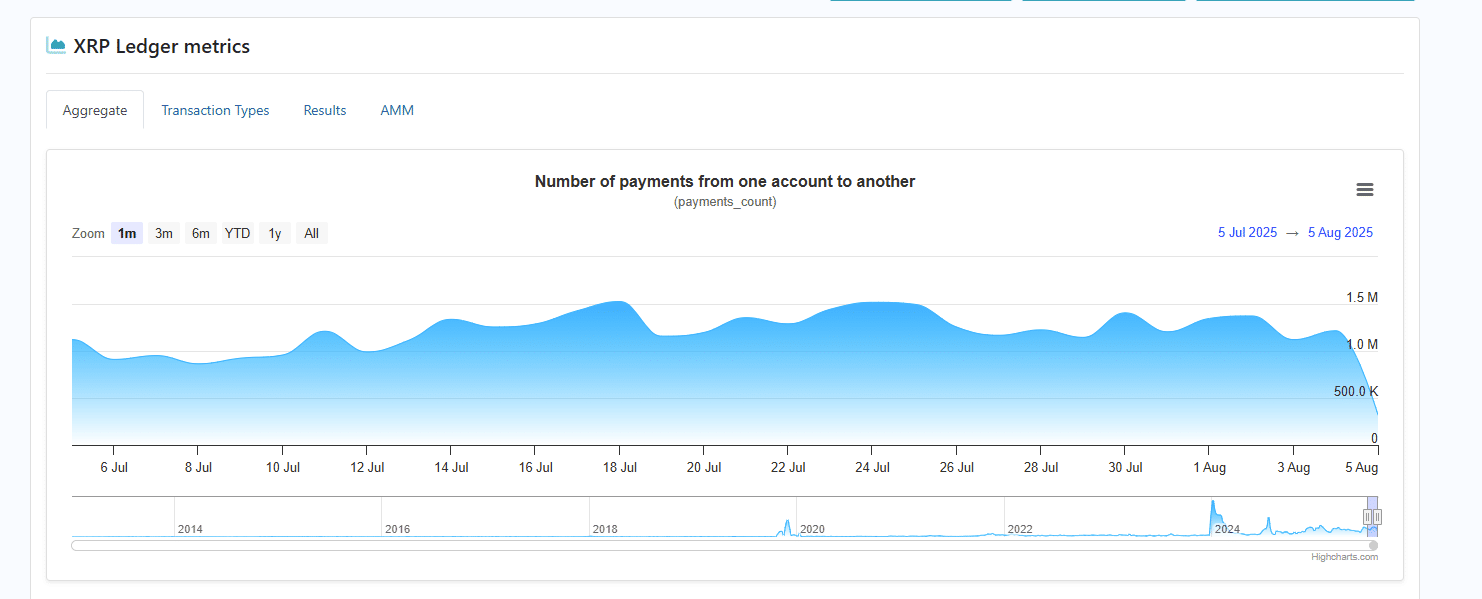Public ledgers like Bitcoin and Ethereum cannot be secure without the community, and XRP Ledger is no exception.
By its very nature as a decentralized network, DLT requires supporters worldwide to run nodes to keep the network operational, process transactions at any time without third parties, and ensure the continuous growth of the blockchain.
The success of Bitcoin spurred the development of improved versions, including the XRP Ledger, which is increasingly gaining market share as Ripple targets institutional growth.
David Schwartz Deploys an XRP Ledger Server in New York
Recently, David Schwartz, the CTO of the XRP Ledger, embarked on a personal mission to enhance the network’s infrastructure, in a mission to reduce
On August 2, Schwartz announced on X that he independently built and launched a custom server in a New York data center, designed specifically to support the XRP Ledger without any ties to Ripple, the private company that operates several solutions, including On-Demand Liquidity, which relies on XRP on the XRP Ledger.
As of August 5, XRP crypto is among the top performers and could be the next crypto to explode.
(Source)
Deploying a custom server to further decentralize the XRP Ledger comes as the network gains traction amid growing adoption in crypto-powered financial systems.
Recent legal developments have also encouraged developers to build on the XRP Ledger, now that there is clarity on XRP’s status as a security under certain circumstances.
As of August 5, 984 nodes and 186 validators were running on different “Rippled” versions.
These nodes and validators help process transactions cost-effectively on the scalable mainnet.
On August 4, the XRP Ledger processed over 1.2 million transactions between accounts.

David Schwartz’ New XRP Ledger Server Details
Schwartz’s server will further strengthen the ledger. The single server features an AMD 9950X processor, 256 GB of RAM, multiple terabytes of SSD and NVMe storage, and a 10 Gbps unmetered internet connection.
It also runs on Ubuntu and is fully synced with the XRP Ledger.
The AMD processor ensures high computational power to handle complex cryptographic operations.
Meanwhile, 256 GB of RAM allows the server to manage large volumes of simultaneous connections and data processing, a critical requirement for supporting multiple nodes and dapps on the network.
By combining SSD and NVMe storage, the server enables rapid data access and high throughput, powering dapps that require low latency for transaction processing.
David Schwartz Is Now Focusing on Performance
Unlike experimental setups, Schwartz, the Ripple CTO, emphasized that this server is not a testbed. Its primary goal is to provide robust connectivity, a critical component for achieving consensus.
To maintain performance, a portion of the server’s capacity is reserved for key nodes, including UNL validators and other priority services. In contrast, the remaining capacity is available to the public on a best-effort basis.
This approach balances the needs of mission-critical operations with those of the community, fostering a more inclusive and resilient network.
Although the server is already online and contributing to the XRP Ledger ecosystem, further testing is required to ensure it can handle production-level workloads reliably.
DISCOVER: The 12+ Hottest Crypto Presales to Buy Right Now
Decentralizing the XRP Ledger Network
Though not tied to Ripple, this initiative aligns with the company’s long-standing efforts to decentralize the mainnet.
In 2018, Ripple announced its decentralization strategy to diversify its validator pool. At the time, Ripple operated over 50% of all validators, raising concerns about decentralization.
To address this, Ripple reduced its validator nodes and encouraged independent entities to run validators. By 2019, many XRP Ledger validators were community-operated, boosting decentralization efforts.
As it is, by offering public access to his server’s resources, Schwartz is empowering the broader XRP community, encouraging them to maintain the network’s health and resilience.
In the long run, his efforts could support XRP prices, as the coin is key in facilitating cross-border payments and providing liquidity to institutions.
DISCOVER: Best Meme Coin ICOs to Invest in 2025
Will XRP Crypto Hit $5?
Like other best cryptos to buy, XRP remains steady, overcoming recent weaknesses.
After reaching all-time highs in mid-July 2025, retraced before rebounding yesterday.
A close above $3.4 could pave the way for new all-time highs and potentially reach $5 in the coming weeks.

(Source)
Optimism is high. On X, one analyst predicted that once XRP breaks $5, it will face no resistance or limits.
DISCOVER: Best New Cryptocurrencies to Invest in 2025 – Top New Crypto Coins
Ripple CTO Decentralizing The XRP Ledger, XRP To $5?
- David Schwartz, the CTO of Ripple, deploys a custom server to decentralize the XRP Ledger
- Server equipped with an AMD 9950X processor, 256 GB RAM, and NVMe storage
- Ripple has decentralized the XRP Ledger validators
- XRP crypto bulls target $5
The post Inside One Man’s Mission to Decentralize XRP Ledger: David Schwartz Takes to New York appeared first on 99Bitcoins.

